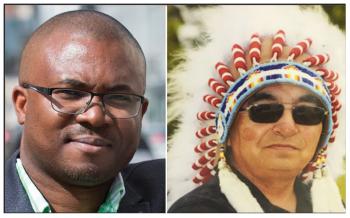Image Caption
Summary
Local Journalism Initiative Reporter
Windspeaker.com
Indigenous communities in northeast Saskatchewan are experiencing a spike in cases of COVID-19 tied to evangelical church meetings in Prince Albert where more than 100 people have been gathering to worship, often without face masks or following social distancing guidelines.
The Peter Ballantyne Cree Nation went into lockdown Thursday after positive cases were identified in the communities of Southend/Reindeer Lake and Deschambault Lake.
“We have to follow the guidelines that are set out for gatherings to prevent the spread of COVID-19. It’s still very dangerous, especially to Elders and people who are health compromised,” said Chief Peter Beatty of Peter Ballantyne Cree Nation.
“Especially in our First Nations communities there are a lot of people that are compromised in their health. If they would get it I know they would suffer all kinds of complications and it could be fatal for them at the end of the day, so that’s why we’re doing the lockdown,” Beatty said.
Six cases were identified in the Lac La Ronge Indian Band community of Stanley Mission Oct. 9, and that community went into lockdown.
At 4 p.m. Oct. 9, three confirmed cases were announced at the Sturgeon Lake First Nation about 30 minutes north of Prince Albert.
Beatty said an individual who was at the religious gatherings in Prince Albert brought the pandemic north.
“We had a case in Southend/Reindeer Lake and then from there the individual travelled to Deschambault and infected three other people there. And then yesterday we found out that an Elder was infected in Southend,” Beatty said.
Because of the distance to emergency treatment centers for some communities, it is imperative to keep the virus from spiralling out of control, Beatty said.
“The nearest that we can go just for immediate triage or any kind of doctor services for emergency would be Flin Flon, Man. or to Prince Albert,” he told Windspeaker.com.
“It's quite a distance for us. Our territory covers most of northeast Saskatchewan so it's quite a distance. It’s a challenge.”
Indigenous Services Canada (ISC) Minister Marc Miller warned on Thursday that First Nations communities need to remain vigilant as COVID-19 cases are on the rise.
“Given what we have seen in the last two weeks, there is little doubt that the second wave of COVID will hit Indigenous peoples harder than the first wave,” Miller said.
Saskatchewan’s Northern Inter Tribal Health Authority (NITHA) Medical Health Officer Dr. Nnamdi Ndubuka agrees.
“Northern Saskatchewan residents are at higher risk compared to in other parts of the province,” Ndubuka said.
“I think there is a need for extra caution… We are already challenged based on the social determinants of health that have resulted in a disparity in health outcomes,” he said.
The most important thing for the public to know right now is that if they have attended the full gospel church rally in Prince Albert they should self-isolate immediately and contact healthline at 811 or their community health clinic for further assessment and testing, said the doctor.
“We really want to encourage northern residents to celebrate their Thanksgiving in a safe way to avoid any risk of transmission. You should avoid face to face gatherings beyond the recommended number based on the public health order,” Ndubuka said.
“It’s important that we contain this particular spread at the moment. People who are organizing any form of event in the community, be it a wake or funeral or a wedding, to please consult with the local public health team so that we can all work together to plan the event in a safe way,” Ndubuka said.
He said now is an opportunity for Indigenous communities to identify any gaps that might have been there in their response to the first wave and that northern communities are at different levels in terms of their ability to respond to the pandemic.
“We encourage the pandemic teams and committees to identify those gaps and try to address them in this window of opportunity,” Ndubuka said.
“I think this is an opportunity for communities to work together to strengthen their capacity, including the capacity for contact tracing, the capacity for testing and the capacity also to isolate cases.”
Beatty said the tentative date to reopen is Oct. 19, but that all depends on the results of further testing, which he said has been made easier this fall because of the GeneXpert machine, which can give results within 45 minutes.
For now, schools are closed and non-essential travel is strongly discouraged. Non-residents who are not essential workers are not allowed in.
“We’re going to be very cautious. Some students are homeschooling and they’re getting materials delivered at home. They’re trying as best they can to keep things going but this has made it very, very difficult for our communities,” Beatty said.
But he said his communities are resilient and residents have learned from past experience with lockdowns.
“We’ve gone through lockdown in the spring already, we’re back to square one again and I think people know what to expect. We’re still awaiting results. We’ll be doing more tracing and more testing. I just got an update on a COVID-19 case. This is just happening now.”
Local Journalism Initiative Reporters are supported by a financial contribution made by the Government of Canada.

